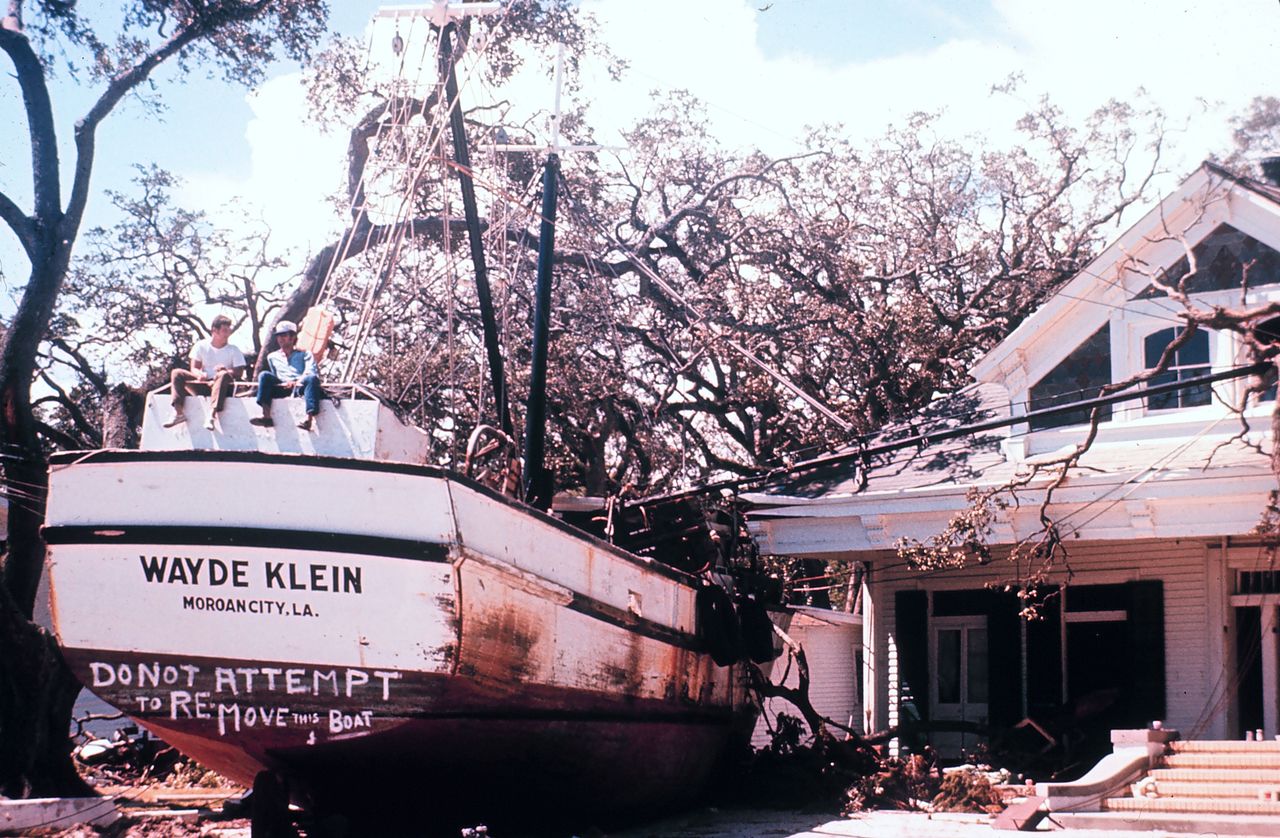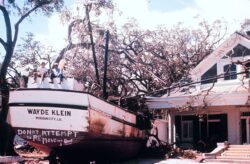Hurricane Camille
Hurricane Camille struck coastal Mississippi in mid-August of 1969, marking the first designated Category 5 storm and one of Louisiana’s most storied tropical weather events.

National Oceanic and Atmospheric Administration
Aftermath of Hurricane Camille.
In mid-August 1969 Louisianans watched a rapidly intensifying Gulf storm with unease. As the third named storm of the season, Camille billowed into to a monstrous Category 5 hurricane before striking Bay St. Louis and Pass Christian, Mississippi, on August 17 with the worst intensity the Gulf Coast had seen in its sordid tropical weather history. As winds, rain, and storm surge tore through the region, Camille brought catastrophic damage to the Gulf Coast. Despite a considerable impact on the state—259 deaths, 2,000 injured, and $1.42 billion in damages ($10 billion in 2020 USD)—Louisiana is often brushed aside during conversations about Camille in order to focus on the more heavily damaged Mississippi Gulf Coast. Despite this fact Camille’s impact on Louisiana was significant, leading to death and injury, property damage, mass displacement, infrastructure failure, and economic losses for local industries.
Preparations
Four years prior to Camille, Hurricane Betsy devastated Louisiana with a direct blow to New Orleans that brought $1 billion in damage ($7.06 billion in 2020 USD). Hence as residents eyed Camille in 1969 they worried whether their defenses were ready. While broken levees near the Industrial Canal in New Orleans had been repaired, weaker links in the state’s levee system remained. Similarly, efforts to corral flooding in lower coastal parishes and along the Mississippi River through areas like Plaquemines Parish as part of federal flood projects were still in progress. Moreover, many residents were still updating their properties and rebuilding after Betsy. In short, whatever Camille would bring with it was likely to impact the state.
As Red Cross shelters opened across Louisiana, Mississippi, and Alabama in preparation for the arrival of a large and intense storm, more than 70,000 residents hunkered down. Forty-six shelters in the New Orleans area swelled to accommodate nervous residents suffering from late-season hurricane fatigue as Camille churned one hundred miles out from the mouth of the Mississippi River. After passing just right of the river’s bird’s foot delta, the storm missed a direct hit to Louisiana but dealt devastating peripheral damage to the state’s eastern coastal and Florida Parishes.
Impact
Roughly sixty miles from the hurricane center, Orleans and Jefferson Parishes suffered relatively light destruction, with much of the impact resulting in power outages, flooding, and wind damage. The one exception was in New Orleans’s Lower Ninth Ward, where a levee break in the Industrial Canal looked eerily familiar to breaks during Betsy. In the early hours of Monday morning residents on either side of the Industrial Canal near Florida Avenue and N. Galvez Street were awakened by eleven police buses, a fire department flotilla, and thirty-eight National Guard trucks that scrambled to evacuate residents to shelters as the water poured in from a levee break on the lower side of the canal. According to the Times-Picayune efforts to fix the canal break began immediately, “with crews containing the break in the levee on the downtown side of the canal shortly after the storm-driven water began going over the levee.”
Areas south, north, and east of New Orleans did not get off so lightly. The damage was catastrophic in five Louisiana parishes, including Tangipahoa, Plaquemines, St. Tammany, St. Bernard, and Washington, the last four of which were declared federal disaster areas by then-President Richard Nixon.
In St. Bernard Parish the newly finished Mississippi River Gulf Outlet spilled over as the storm surge rolled in. According to the Times-Picayune in Yscloskey, Reggio, Shell Beach, Bayou Terre aux Boeuf, and at Delacroix Island, the roofs of homes and businesses were left “wind-mutilated and, in some cases, gone altogether.” Hopedale residents in particular saw damage to 80 percent of their homes.
Just west, Plaquemines Parish paid the highest price of any Louisiana parish due to its position on the coast and vulnerabilities caused by both the river and external levee systems. Winds in the area reached up to 100 mph. As the Times-Picayune reports, driving between Belle Chasse toward Port Sulphur, light damage was visible, but moving closer toward Empire, the “picture steadily changed and each mile traveled showed increasing devastation.” A Mississippi River levee break caused by surging storm water devastated twenty-six miles from Empire to Venice, affecting the 5,000 residents along the route. “It made Betsy and the 1915 storm seem like child’s play,” said an Empire resident to the Times-Picayune who also called the levee system “a death trap,” as residents got stuck between two bodies of water that wrought havoc on the lands in between. Then-Governor John J. McKeithen agreed. “It’s utter devastation,” he reported to the Times-Picayune a day after viewing the damage.
Governor McKeithen also noted destruction between Slidell and Bogalusa, as heavy rain and wind damage impacted the Florida Parishes. In Bogalusa, for example, at least 500 trees were left scattered across the city, and the National Guard was called out to prevent looting in the aftermath. Meanwhile, 110,000 residents lost power due to rain-soaked trees that the Times-Picayune notes “popped power lines” in areas like Angie, Bush, Pearl River, Lee’s Creek, and Varnado.
In addition to property destruction Camille also impacted natural wildlife as well as the agriculture and petrochemical industries. In Plaquemines Parish citrus crops suffered a total loss due to the number of trees ripped from the ground. Meanwhile, a vast number of cattle, deer, fish, and alligators drowned due to flooding. But the largest impacted industries experiencing damage by Camille was the petrochemical industry in Louisiana. An estimated 4,000 wells closed because of the storm, and heavy losses were sustained to equipment throughout. Companies like Chevron, Shell, Getty, Humble and Gulf, J. Ray McDermott Co., and others had trouble getting workers back to damaged drill sites as wrecked tanks, surface control equipment, and pipelines left a scattered minefield of potential death traps to aircraft and boats alike. Worse yet, the $100-million damage (1969 USD) to the region’s oil and gas industry due to Camille marked the close of an extremely costly period for the petrochemical industry in the face of a decade of hurricanes, let alone the unknown cost felt in environmental impact to wildlife and marine life impacted by oil slicks from affected petrochemical operations.
Legacy
While Louisiana’s damages from Camille were extensive in areas like Plaquemines and the West Florida Parishes, where the storm left some 10,000 Louisianans homeless, much discussion of Camille’s impact is often reserved for Mississippi’s devastated coastal areas. As of 2020 there is no marker to commemorate Camille in Louisiana, but residents still remember the storm as the last “big one” until Hurricane Katrina in 2005. However, the storm’s legacy in Louisiana is commemorated through the continued use of the Saffir-Simpson Hurricane Wind Scale, which was implemented to measure sustained wind, size, and even rain outputs after Camille left its deadly impact on areas like Plaquemines and the West Florida Parishes. Perhaps appropriately, Camille was the first designated “Category 5” storm.
